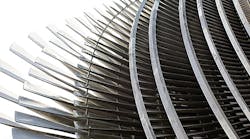LIFT, the Lightweight Innovations for Tomorrow initiative, is turning its research focus to materials engineering in the third industrial-academic partnership it has launched since last summer. The project will seek strategies for expanding the potential uses of titanium alloys in aircraft engines and other aerospace applications by reducing the cost of designing and testing parts.
Specifically, the researchers aim to develop computer models that will cut the time and cost of materials development, component design, and manufacturing by 50%. New “computational tools” also will be developed, according to Alan Taub, LIFT’s chief technology officer.
Taub predicted the new tools also would improve manufacturing of titanium components.
“The cost of titanium itself and the time it takes to design and test new components are significant barriers. If this partnership between industry and academia can lower that barrier, it will encourage more use of this very versatile lightweight metal,” according to Lawrence E. Brown, executive director of LIFT.
“Turbine fans in aircraft engines, for example, operate in demanding conditions, but are critical to maintaining high performance," he continued.
GE Aviation and The Ohio State University’s Light Metals and Manufacturing Research Laboratory are conducting the research. Also participating will be EWI, Purdue University, Southwest Research Institute, University of Michigan, and the University of North Texas.
Joining the lead research partners are The Boeing Co. and Scientific Forming Technologies Corporation, a developer of engineering software (DEFORM) used by designers to analyze metal forming, heat treatment, machining and mechanical joining processes.
According to GE Aviation’s Thomas F. Broderick, senior staff engineer, structural materials development, "Our interests emphasize development of computational means to predict fatigue and ballistic impact resistance within the highly transformed microstructures that are formed about the solid state weld interface.”
LIFT is a “manufacturing innovation institute” operated by the American Lightweight Materials Manufacturing Innovation Institute, a partnership formed in 2014. It coordinates academic and institutional research with likely and/or available industrial partners, with specific development targets.
In 2015 it announced two research initiatives, the first to optimize production techniques for lightweight ductile iron applications, and the second to develop vacuum-aided diecasting technologies for aerospace, defense, and automotive applications.
“Titanium is expensive, and engineers have to ‘make and break’ a lot of test parts before they can be sure the design is right for a critical component of an airplane engine,” said Taub, explaining the latest research program.
“If we can advance the abilities of our computer models to better predict how a particular design will perform, we can test less,” he continued. “That cuts material and testing costs and the lead time for developing new designs.”









